
Wheeler & Woolsey were an American vaudeville comedy double act who performed together in comedy films from the late 1920s. The team comprised Bert Wheeler (1895–1968) of New Jersey and Robert Woolsey (1888–1938) of Illinois.

Leon Errol was an Australian-American comedian and actor in the United States, popular in the first half of the 20th century for his appearances in vaudeville, on Broadway, and in films.
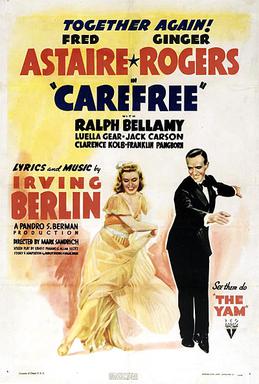
Carefree is a 1938 American musical comedy film directed by Mark Sandrich and starring Fred Astaire, Ginger Rogers and Ralph Bellamy. With a plot similar to screwball comedies of the period, Carefree is the shortest of the Astaire-Rogers films, featuring only four musical numbers. Carefree is often remembered as the film in which Astaire and Rogers shared a long on-screen kiss at the conclusion of their dance to "I Used to Be Color Blind," all previous kisses having been either quick pecks or simply implied.

Dixiana (1930) is a lavish American pre-Code comedy, musical film directed by Luther Reed and produced and distributed by RKO Radio Pictures. The final twenty minutes of the picture were photographed in Technicolor. The film stars Bebe Daniels, Everett Marshall, Bert Wheeler, Robert Woolsey, Joseph Cawthorn, Jobyna Howland, Ralf Harolde, Bill "Bojangles" Robinson and Dorothy Lee. The script was adapted by Luther Reed from a story by Anne Caldwell.
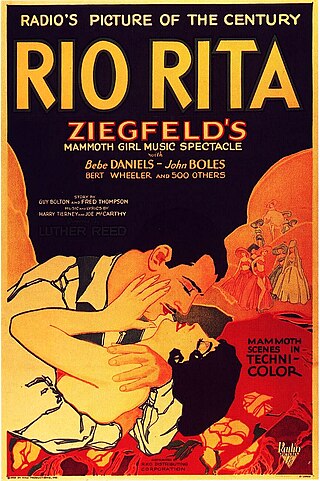
Rio Rita is a 1929 American pre-Code RKO musical comedy starring Bebe Daniels and John Boles along with the comedy team of Wheeler & Woolsey. The film is based on the 1927 stage musical produced by Florenz Ziegfeld, which originally united Wheeler and Woolsey as a team and made them famous. The film was the biggest and most expensive RKO production of 1929 as well as the studio's biggest box office hit until King Kong (1933). Its finale was photographed in two-color Technicolor. Rio Rita was chosen as one of the 10 best films of 1929 by Film Daily.

The French Line is a 1953 American musical film starring Jane Russell made by RKO Radio Pictures, directed by Lloyd Bacon and produced by Edmund Grainger, with Howard Hughes as executive producer. The screenplay was by Mary Loos and Richard Sale, based on a story by Matty Kemp and Isabel Dawn. It was filmed in three strip technicolor and dual-strip polarized 3D during what many consider 3-D film's "golden era" of 1952–1954.
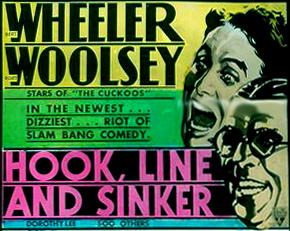
Hook, Line and Sinker is a 1930 American pre-Code slapstick comedy directed by Edward F. Cline from a screenplay by Ralph Spence and Tim Whelan. It was the third starring vehicle for the comedy team of Wheeler & Woolsey, and also featured Dorothy Lee. It would be one of the largest financial successes for RKO Pictures in 1930.

Manhattan Parade is a 1931 American pre-Code musical comedy film photographed entirely in Technicolor. It was originally intended to be released, in the United States, early in 1931, but was shelved due to public apathy towards musicals. Despite waiting a number of months, the public proved obstinate and the Warner Bros. reluctantly released the film in December 1931 after removing all the music. Since there was no such reaction to musicals outside the United States, the film was released there as a full musical comedy in 1931.
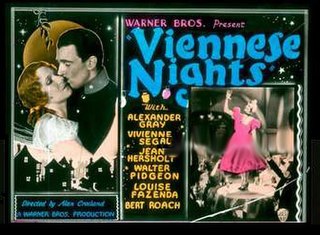
Viennese Nights is a 1930 American all-talking pre-Code musical operetta film directed by Alan Crosland and starring Alexander Gray, Vivienne Segal, Walter Pidgeon, Jean Hersholt, Bela Lugosi and Louise Fazenda. It was photographed entirely in Technicolor and released by Warner Brothers. Viennese Nights was the first original operetta written especially for the screen by Oscar Hammerstein II and Sigmund Romberg. It was filmed in March and April 1930, before anyone realized the extent of the economic hardships that would arrive with the Great Depression, which had begun in the autumn of the previous year. Although not a box office hit in the United States, the film had long box office runs in Britain and Australia. It is one of the earliest sound films to have a short pre-credit sequence.
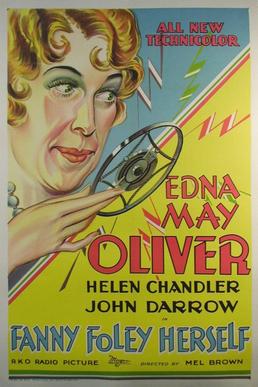
Fanny Foley Herself is a 1931 American pre-Code comedy-drama film shot entirely in Technicolor. The film was the second feature to be filmed using a new Technicolor process, which removed grain and resulted in improved color. It was released under the title Top of the Bill in Britain. It survives in a complete Technicolor copy under that title at the BFI.

The Cat and the Fiddle is a 1934 American pre-Code romantic musical film directed by William K. Howard based on the hit 1931 Broadway musical of the same name by Jerome Kern and Otto A. Harbach, about a romance between a struggling composer and an American singer. The film stars Ramon Novarro and Jeanette MacDonald in her MGM debut.

The Cuckoos is a 1930 American Pre-Code musical comedy film released by RKO Radio Pictures and partially filmed in two-strip Technicolor. Directed by Paul Sloane, the screenplay was adapted by Cyrus Wood from the 1926 Broadway musical The Ramblers by Guy Bolton, Bert Kalmar and Harry Ruby. The film stars Bert Wheeler and Robert Woolsey, and while they had appeared on Broadway and in other films together, this was their first time starring as a team. The success of this picture, combined with Rio Rita being their most successful film of 1929, convinced the studio to headline them as the comedy team Wheeler & Woolsey, through 1937.
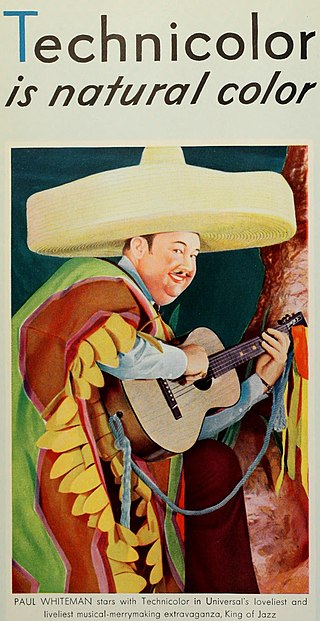
Technicolor is a family of color motion picture processes. The first version, Process 1, was introduced in 1916, and improved versions followed over several decades.

Joseph Bridger Cawthorn was an American stage and film comic actor.
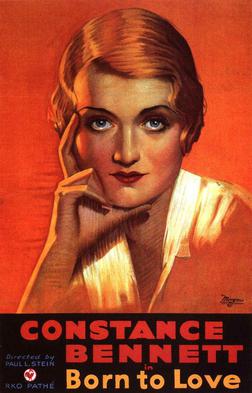
Born to Love is a 1931 American pre-Code melodrama film, directed by Paul L. Stein from an original screenplay by Ernest Pascal. It starred Constance Bennett, Joel McCrea and Paul Cavanagh in a lovers' triangle set in London during World War I. It was only the second film produced by RKO Pathé after the merger of the two studios, and according to RKO records, it made a profit of $90,000.

Sin Takes a Holiday is a 1930 American pre-Code romantic comedy film, directed by Paul L. Stein, from a screenplay by Horace Jackson, based on a story by Robert Milton and Dorothy Cairns. It starred Constance Bennett, Kenneth MacKenna, and Basil Rathbone. Originally produced by Pathé Exchange and released in 1930, it was part of the takeover package when RKO Pictures acquired Pathé that year; it was re-released by RKO in 1931.

White Shoulders is a lost 1931 American pre-Code comedy-drama film directed by Melville W. Brown and starring Mary Astor and Jack Holt, with major supporting roles by Ricardo Cortez and Sidney Toler. The film was produced and distributed by RKO Pictures. The screenplay by Jane Murfin and J. Walter Ruben was adapted from Rex Beach's short story, The Recoil.

Numbered Men is a 1930 American pre-Code prison drama film produced and released by First National Pictures, a subsidiary of Warner Bros., and directed by Mervyn LeRoy. The movie stars Bernice Claire, Conrad Nagel, Raymond Hackett and Ralph Ince. The film was based on the play entitled Jail Break by Dwight Taylor.
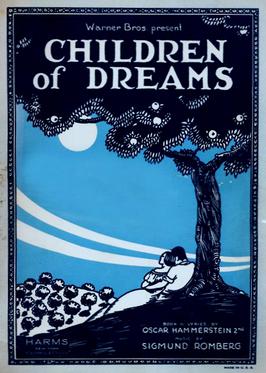
Children of Dreams is a 1931 American pre-Code musical operetta drama film photographed entirely in Part Technicolor and produced and distributed by Warner Bros.



















